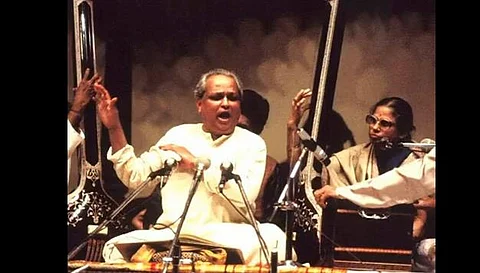

Nidhi Jamwal*
SOLUKHUMBU (Nepal): Day 8 of the trek. I walked with leaden feet, struggling to breathe in the high-altitude Everest region in Nepal. Every step I took on the dry and rocky terrain of the Himalayas felt like the last. Would I make it to the Everest Base Camp located at an altitude of 5,364 metres above mean sea level (masl)?
In between thinking longingly of my family and my comfortable home back in Mumbai, which was on a blessedly even terrain at sea level, lines from a book kept coming back to me as I trudged painfully towards the Khumbu glacier.
No, it was not anything Tenzing Norgay or Edmund Hillary, who summitted Everest in 1953, had said. It was what the biographer of classical vocalist Kumar Gandharva had written in his book Kumar Gandharva: An Improbable Life, a richly illustrated biography.
I had read the 91-page book, written by Sopan Joshi, just before I embarked on the Himalayan Climate Boot Camp in May this year. The camp was organised by Nepal Forum of Science Journalists to help journalists from SAARC countries understand the challenges of climate change in the Everest region.
So, there I was, walking from Gorakshep (5,164 m), the last village in the Solukhumbu district of northeastern Nepal, to reach the Everest Base Camp, and lines from the book swam into my consciousness.
Kumar Gandharva had nothing to do with either climate change or the Everest region. But the human mind is a strange thing and out of nowhere, retrieves thoughts that then keep playing in the mind like a playlist on a loop.
“His left lung contracted tuberculosis at the age of twenty-five. It is pure marvel that he not just thrived but also sang till sixty-seven.”
“At the peak of his youth, he struggled to speak for five years and spent most of that period lying down.”
These lines from the book pushed me to take the next step and then the next one. Imagine someone losing a lung to tuberculosis (TB) in his mid-20s, struggling to speak for five years, but overcoming his physical shortcomings to become a global sensation.
Surely, the breathlessness I was feeling in Gorakshep was nothing compared to what Kumar Gandharva must have lived with, I told myself.
Many things about the life of the Hindustani vocalist are inspiring. He was born Shivaputra, on April 8, 1924, in a village in north Karnataka. The title of Kumar Gandharva came nine years later.
Shivaputra’s childhood was spent in poverty and distress. The biography, published in October 2023, notes that the family “did not have any food grains in the house the day Shivputra was born… the family had to wait for the rainy season to end to have a dry spot to sleep peacefully.”
His father, Sidharamaiya, was fond of classical music and it was at the age of seven when Shivaputra broke into a song that his family realised he had a special gift. Young Shivputra had an astonishing ability to grasp music. If he heard a song, he memorised it almost instantly and sang it back. At the age of eleven, he left home and headed to Mumbai (then Bombay) to train under classical singer BR Deodhar.
In April 1947, he married Bhanumati Kauns, another student at the Deodhar school. But Shivaputra was diagnosed with TB in his left lung, and the couple moved to Dewas in Madhya Pradesh, as advised by the doctors.
For five years, Kumar was bedridden. He was constantly tired and in pain and lost up to three-fourths of his left lung to TB. He could not sing and no singing meant no income.
As he lay in bed, he noticed a small bird that was making “an awful lot of noise” while making its nest. That bird somehow inspired Kumar and he decided not to give up singing. In 1952, the fifth year of his illness, he began re-training himself to sing. And also started putting together a library of music and poetry.
In 1956, the couple was blessed with their first child, a son. Their second son was born in 1961, but Bhanumati died due to post-birth complications. He remarried and his second wife, Vasundhara Shrikhande, became his partner in music.
Despite the hardships, he faced, Kumar Gandharva remained a caring and sensitive person. Kumar’s friend Ladli Mohan Nigam once asked him about having TB at the peak of his life.
The maestro replied: “Those five to seven years that I was laid up with illness gave me the space to really understand music and to approach it in new, innovative ways… What I earned in those five to seven years of illness gave me so much more than anything I could have achieved if I had continued to sing the way I was singing then.”
Kumar Gandharva gave his last public performance in Pune on December 11, 1991, after he had suffered a severe attack of bronchitis. At the Sawai Gandharva Music Festival, he sang his heart out. He breathed his last a month later, on January 12, 1992, in Dewas.
As I walked towards the Everest Base Camp, it was what Kumar Gandharva told his friend Nigam that I could not get out of my head. Here was a man, one of India’s finest classical singers, who turned all his life’s pain, trauma, and heartbreak into beautiful music. How many of us can do that?
Kumar Gandharva: An Improbable Life was published by Jugnoo Prakashan, an imprint of Ektara Trust in Bhopal (MP). It is priced at INR 325. It is also available in Hindi as Shivputra Katha: Kumar Gandharva Ki Jeevni.
*Nidhi Jamwal is a Mumbai-based journalist who writes on environment, climate, and rural issues. Her handle on X is @JamwalNidhi
—–
Have you liked the news article?